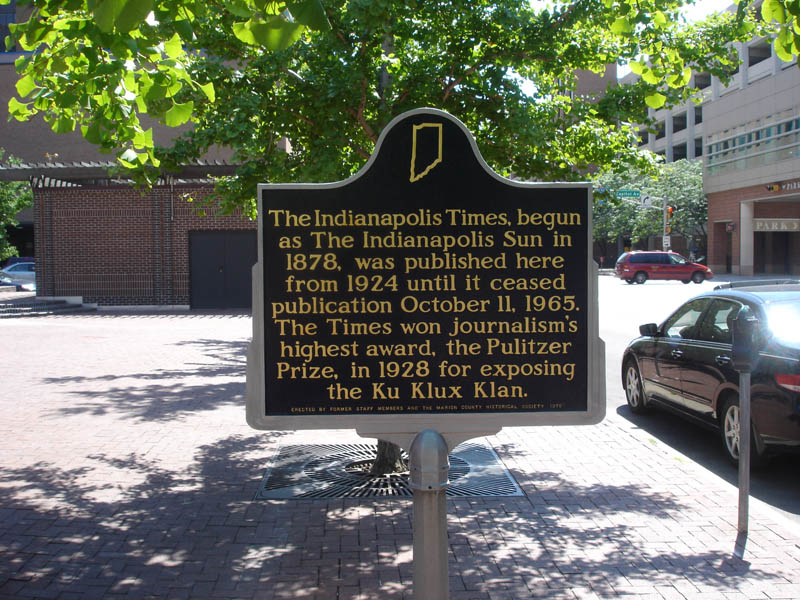
|
Broad Ripple Random Ripplings

The news from Broad Ripple
Brought to you by The Broad Ripple Gazette
(Delivering the news since 2004, every two weeks)

|
| Brought to you by: |

|

|

|

|

|

|
Converted from paper version of the Broad Ripple Gazette (v05n22)
The Indianapolis Times - supplying news to Indy from 1888 to 1965 - By Larry Warner
posted: Oct. 24, 2008
A historical marker now stands in the 300 block of West Maryland Street. It marks the location where "The Indianapolis Times" once stood.
If you happen to locate the marker and pause to read it, you will learn that "The Indianapolis Times" ceased operations on October 11, 1965.

image courtesy of Larry Warner
For many of us, we can recall the time when Indianapolis had three daily newspapers. . . "The Times", "The Star" and "The News." The "Times" and "The Star" published seven days a week, "The News", an evening paper like "The Times" did not have a Sunday edition.
If one wanted to research the history of "The Times" you would find very little reference material. The "Times" was once part of the Scripps-Howard chain of newspapers. The Howard in Scripps-Howard was Roy Howard, a native of Indianapolis and Manual High School grad. The "Times" was a feather in Howard's cap and he was proud to be associated with the paper. This probably accounted for part of "The Time's" longevity.
In its storied past, "The Times" won the Pulitzer (Journalism's highest award) in 1926 for its coverage of the Ku Klux Klan in Indiana.
"The Times" was founded as "The Sun" in 1888 and originally located on the south side of Ohio Street between Pennsylvania and Delaware. It then moved to a site on Georgia Street between Meridian and Pennsylvania before moving to its last location at 214 West Maryland in 1924.
As described in the Encyclopedia of Indianapolis,
Long noted for "lively and sometimes courageous journalism", the Times was frequently engaged in crusades against injustice and corruption on both a cityand a state level. In addition to its coverage of Klan activity in the 1920s, the Times also played a key roll in exposing state highway scandals of 1957-1958; voter fraud in the 5th district during the election of 1960, and a scandal involving mechanics' liens in 1961-1962. In 1961 the Times found local jobs for nearly 4,000 unemployed Hoosiers by running help wanted ads for free, and in 1962 the paper's exposure of errors in the reporting of crime statistics in Indianapolis, a practice that disguised the city's growing crime rate, led to enlarged street patrols by police. From 1960 to 1964 the Times waged a successful campaign to persuade the Indianapolis Public School system to provide better school lunches through the use of the federal surplus food program.
Several former "Times" employees still live in the Indianapolis area and have fond memories of their days with the paper.
Jim Hetherington, former Assistant City Editor, recalls a time when then Managing Editor Irving Leibowitz (Leibo) took on a local mobster in his daily column. Leibo got word that the mobster was on his way up to see him, ducked under his desk and left Hetherington to shoo the colorful mobster out of the building.
A favorite story of Carl Henn, copy editor, was when he once heard a fire call over the police/fire radio, looked up the address and telephone, called the residence number and got the home owner. Carl asked "what are you doing?" and the home owner responded "answering the phone. . . but I got to leave. . . it's getting hot in here."
Reporter Gerry LaFollette recalls the JFK shooting and the Coliseum explosion happening just weeks apart and tells the story about "The Times" running out of paper because of extra editions and having to send a truck over to the "Star-News" to borrow additional newsprint so it could continue to publish.
Over the years, "The Times" found it more and more difficult to compete against its rivals, in terms of paid circulation and advertising revenue. When the paper ceased to publish it was the third ranked paper in the market with a circulation of only 89,000+ and a Sunday circulation of about 101,000.
On its last day in operation, "The Times" sold an additional 10,000 copies of the final paper, now a collector's item, causing long-time television columnist R.K. Shull to quip "we should do this every week."
Larry Warner's history with the Times: When Larry was a Junior and Senior at Manual High School (1953 & 54) he worked Fridays and Saturday evenings helping gather and write the High School football and basketball games and box scores. He graduated from Manual in 1955 and went to IU the following September. When he got off of active duty in the Army in 1962 he went to work at The Times on the City Desk...covering the Federal Building and filling in on Saturdays on the Police Beat. He was there for two years.

|

|

|
| Brought to you by: |

|

|

|
| Brought to you by: |

|

|

|
| Brought to you by: |

|

|

|
| Brought to you by: |


